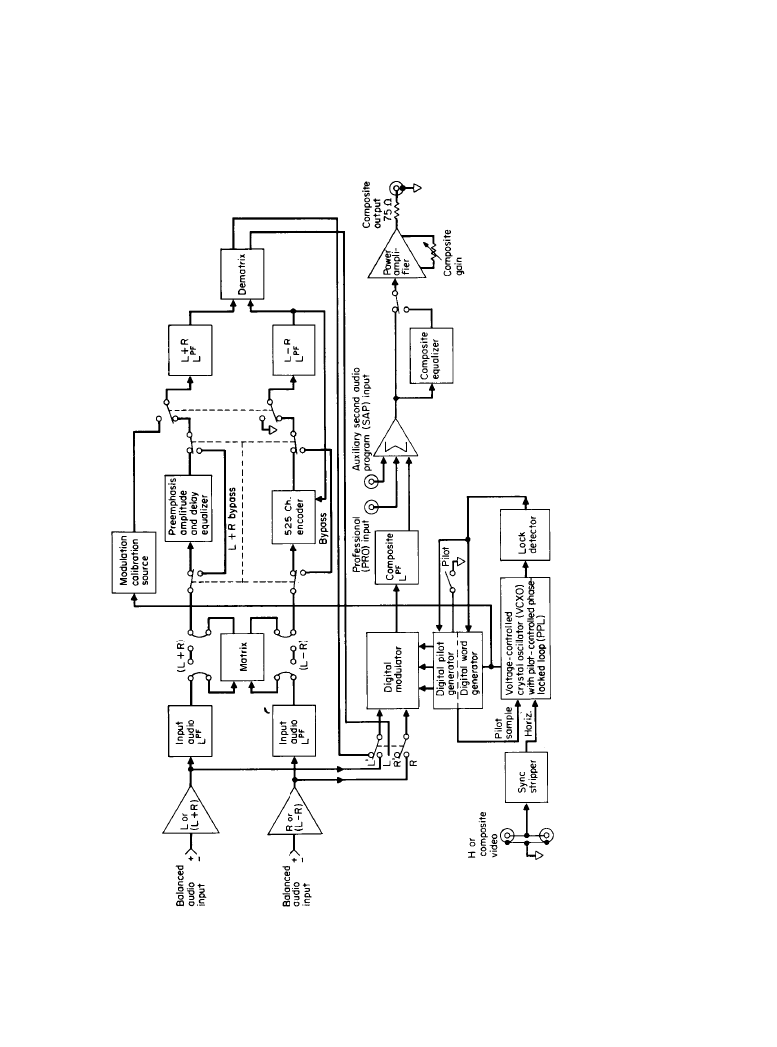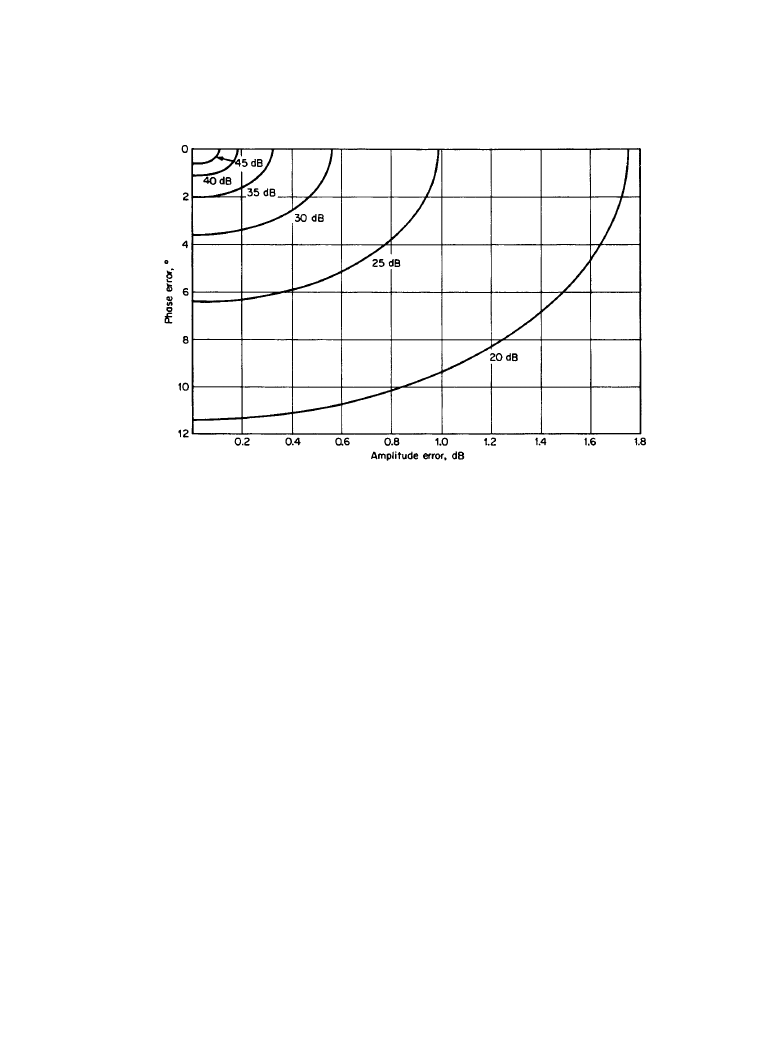ВУЗ: Казахская Национальная Академия Искусств им. Т. Жургенова
Категория: Книга
Дисциплина: Не указана
Добавлен: 03.02.2019
Просмотров: 21599
Скачиваний: 19

12-78 Radio Receivers
cal to that in L + R. This function was included to allow noise, distortion, and separation mea-
surements to be made without the level-dependent degradation caused by noise reduction.
Subchannel Filters
Subchannel filters serve to limit the noise-reduction-control-line bandwidth and to control the
out-of-band energy created by the noise reduction circuit. When there is no audio input to the
noise reduction circuitry, the spectral compressor gain is at maximum, creating a high-level par-
abolic noise spectrum which needs to be bandwidth-limited to audio frequencies to prevent spec-
trum spillover. Because the pilot is separated from the subchannel by only 734 Hz, the filter
slope needs to be very sharp to provide pilot protection with flat response to 15,000 Hz.
Any out-of-band information on the noise-reduction-control line (such as f
H
) after the sub-
channel filter will cause the noise reduction circuitry to misencode, causing degradation of
received separation and frequency response when decoded. To ensure stereo separation greater
than 40 dB, the subchannel filters need to be matched to within 0.08-dB amplitude difference
and 1° phase difference. For good overall frequency response, the filter's response should be less
than ±0.2 dB from 50 to 15,000 Hz.
The stereo-generator frequency response should be less than ±1 dB from 50 to 15,000 Hz
(with noise reduction) and ±0.5 dB without noise reduction to help meet the total-system
response goals.
12.4.2b
Audio System Specifications and Performance Objectives
Specifications of particular importance for TV stereo audio generator operation include fre-
quency response, separation. crosstalk, spurious suppression, and deviation calibration.
Table 12.4.1 Modulation Standards for the TV MTS System
Service or
Signal
Modulating
Signal
Modulating
Frequency
Range, kHz
Audio
Processing
or
Preemphasis
Subcarrier
Frequency
(
f
H
= 15.734
kHz)
Subcarrier
Modulation
Type
Subcarrier
Deviation,
kHz
Aural
Carrier
Peak
Deviation,
kHz
Monophonic
L + R
0.05–15
75
µ
s
25*
Pilot
f
H
5
Stereophonic
L – R
0.05–15
BTSC
compression
2
f
H
AM-DSB SC
50*
Second Audio
Program
0.05–10
BTSC
compression
5
f
H
FM
10
15
Professional
Channel
Voice
0.3–3.4
150
µ
s
6.5
f
H
FM
3
3
Data
0–1.5
0
FSK
* Sum does not exceed 50 kHz
Downloaded from Digital Engineering Library @ McGraw-Hill (www.digitalengineeringlibrary.com)
Copyright © 2004 The McGraw-Hill Companies. All rights reserved.
Any use is subject to the Terms of Use as given at the website.
Stereo Television

Stereo Television 12-79
Figur
e 12
.4.3
St
er
eo-
ge
ner
a
to
r b
loc
k
d
ia
g
ra
m
.
Downloaded from Digital Engineering Library @ McGraw-Hill (www.digitalengineeringlibrary.com)
Copyright © 2004 The McGraw-Hill Companies. All rights reserved.
Any use is subject to the Terms of Use as given at the website.
Stereo Television

12-80 Radio Receivers
Frequency Response
Frequency response performance is the deviation from a constant amplitude across a particular
span of frequencies [5–7]. Researchers have found that under some conditions, variations as
small as ±0.2 dB can be discerned, especially in the ear's critical 100– to 10,000–Hz range.
Because the ear is less sensitive to response errors at the extremes, an audio-system specification
of ±0.5 dB from 50 to 15,000 Hz and of ±0.25 dB from 100 to 10,000 Hz is adequate to deliver
excellent audio.
A total-system specification of ±1 dB from 50 Hz to 15,000 Hz, including the stereo encoder
and RF chain, is a realizable system performance target. Fortunately, most solid-state mixers and
distribution amplifiers have frequency response specifications much better than those given
above. Unfortunately, much of the source material, such as videotape and network programming,
will not be quite that good unless noise reduction or digital encoding is employed.
Signal-to-Noise Ratio (SNR)
Signal-to-noise ratio is the amplitude difference, usually expressed in decibels, between a stan-
dard-level audio signal and the residual noise and hum of the system. The S/N of any equipment
in the audio chain should be greater than 65 dB (unweighted). This performance level will ensure
that the source S/N or the transmitter FM SNR will be the limiting factor in the system noise
contribution. The performance target for the entire system should be greater than 58 dB.
Total Harmonic Distortion (THD)
Total harmonic distortion is the creation by a nonlinear device of spurious signals harmonically
related to the audio waveform. Research has shown that although THD levels greater than 1 per-
cent are easily detectable during sine-wave testing, people will tolerate somewhat higher levels
of THD on musical material. THD in any part of the audio chain should be less than 0.25 percent
from 50 to 15,000 Hz, and the whole audio chain should be less than 0.5 percent THD from 50 to
15,000 Hz. A performance target for the entire system (RF included) should be 1 percent from
50 to 15,000 Hz.
Although harmonics of frequencies greater than 7500 Hz will be attenuated by the 15,000-Hz
low-pass filters in the TV MTS generator, the presence of these harmonics in the audio stages
before the generator may raise the level of intermodulation-distortion products in the audio sig-
nal.
The THD test is sensitive to the S/N of the device under test. If the device has an S/N of 60
dB, the distortion analyzer’s best distortion reading will be greater than 0.1 percent (60 dB =
0.001 = 0.1 percent). An audio spectrum analyzer will allow true THD readings because it will
disregard the broadband noise floor of the tested device.
Intermodulation Distortion (IMD)
Intermodulation distortion is the creation by a nonlinear device of spurious signals not harmoni-
cally related to the audio waveform. These distortion components are sum-and-difference (beat
notes) mixing products that research has shown are more objectionable to listeners than even har-
monic-distortion products. The IMD (60 Hz/7000 Hz mixed 4:1 amplitude ratio), measured in
accordance with Society of Motion Picture and Television Engineers (SMPTE) guidelines,
should be less than 0.25 percent for each part of the audio chain and less than 0.5 percent for the
Downloaded from Digital Engineering Library @ McGraw-Hill (www.digitalengineeringlibrary.com)
Copyright © 2004 The McGraw-Hill Companies. All rights reserved.
Any use is subject to the Terms of Use as given at the website.
Stereo Television

Stereo Television 12-81
entire audio chain. The IMD measurement is not greatly affected by the noise floor of the tested
device. A performance target for the entire system (including RF) should be 1 percent IMD or
less.
Separation
Separation is a specialized definition for signal crosstalk between the left and right channels of a
stereo system. The minimum amount of stereo separation needed to define a stable stereo image
has been found to be greater than 17 dB at the listener's position. Stereo separation can be
degraded at almost any link in the transmission chain, requiring much greater than the nominal
17 dB to be necessary for the audio chain. A separation requirement of greater than 50 dB from
50 to 15,000 Hz should be the minimum for each piece of equipment in the audio chain. The
entire audio system should have separation performance of greater than 40 dB from 400 to
15,000 Hz and 35 dB from 50 to 400 Hz. A performance target for the entire system (including
RF) should be 30 dB from 100 to 12,000 Hz and 20 dB from 50 to 15,000 Hz.
Headroom
Headroom is the difference (in decibels) between the normal operating level and the maximum
output level of the device being tested. In equipment monitored by volume-unit (VU) types of
meters, the equipment should have 15 dB of headroom above 0 VU, or normal operating level, to
allow for musical peaks that averaging-meter ballistics ignore. When the audio system operates
without sufficient headroom, the time average of the program distortion becomes high enough to
be audible.
Channel-to-Channel Amplitude and Phase Tracking
Channel-to-channel amplitude and phase tracking is the match between the amplitude-versus-
frequency and phase-versus-frequency responses of the stereo channels (L, R). Poor channel-to-
channel tracking will result in a wandering or off-center stereo image and monaural summing
errors that can be very obvious and distracting to viewers. The most obvious error is a com-
pletely out-of-phase condition (L = –R) which gives no mono signal (L + R = 0). The amplitude
and phase match of the L and R channels should be good enough that with both channels driven
with the same amplitude signal, but with one channel inverted (L = –R) and summed electrically,
the residual should be 40 dB below the equivalent L + R level from 50 to 15,000 Hz. The chart in
Figure 12.4.4 gives the amplitude and phase requirements to achieve various crosstalk perfor-
mances.
12.4.2c
Stereo Generator Specifications and Performance Objectives
Although various designs of stereo generators require specific performance measurement
parameters and techniques, the following general categories apply to all devices and systems.
Separation
The separation specification of a stereo generator can be measured in three ways. Generator per-
formance should be better than the FCC Office of Science and Technology Bulletin 60 numbers
given below.
Downloaded from Digital Engineering Library @ McGraw-Hill (www.digitalengineeringlibrary.com)
Copyright © 2004 The McGraw-Hill Companies. All rights reserved.
Any use is subject to the Terms of Use as given at the website.
Stereo Television

12-82 Radio Receivers
•
Baseband (FM) generator (no audio filters included): 50-dB minimum from 50 to 15,000 Hz
•
Noise reduction bypassed (all audio filters included): 40-dB minimum from 50 to 14,000Hz
•
Full-system BTSC mode (all filters and noise reduction included): 30-dB minimum from 100
to 8000 Hz, decreasing to 20 dB at 14,000 Hz, 26-dB minimum at 50 Hz
Linear Crosstalk
Linear crosstalk is leakage from L + R to L – R or L – R to L + R caused by amplitude and phase
matching of L and R channels, which will result in a wandering or off-center stereo image and
monaural summing errors. The stereo-generator linear crosstalk should be better than 40 dB
below 100 percent with all filters in circuit.
Nonlinear Crosstalk
Nonlinear crosstalk is leakage from L + R to L – R or from L – R to L + R caused by distortion
products in L + R or L – R. The distortion products generated in the L – R channel cause interfer-
ence in the SAP (Second Audio Program) or PRO (professional) spectrum. The generator speci-
fication should be better than 70 dB below 100 percent.
Spurious Suppression
Spurs are caused by nonlinearities in the AM-DSB (double-sideband) modulation of L – R.
These unwanted distortion products can cause noise and whistles in the SAP and PRO channels,
Figure 12.4.4
Crosstalk versus amplitude and phase errors.
Downloaded from Digital Engineering Library @ McGraw-Hill (www.digitalengineeringlibrary.com)
Copyright © 2004 The McGraw-Hill Companies. All rights reserved.
Any use is subject to the Terms of Use as given at the website.
Stereo Television